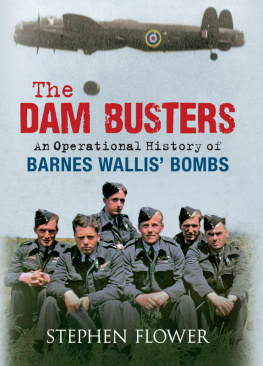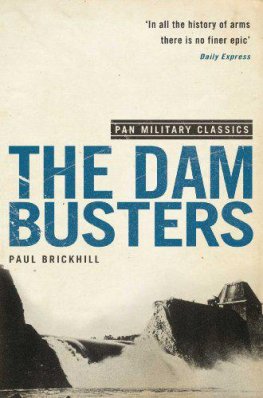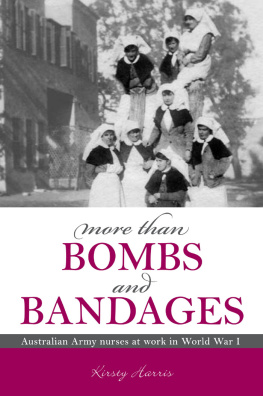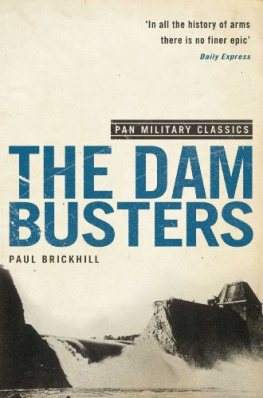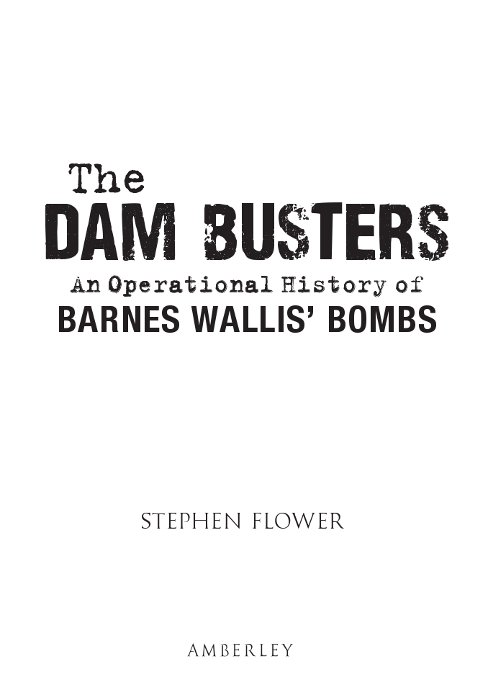Acknowledgements
This book came about as a result of the research carried out by me since 1986 into Brooklands airfield and its wartime products. It could not have been written without the help of many people, who often unwittingly contributed towards it.
At the head of this list must come the staff of the National Archives at Kew, followed by their colleagues at the RAF Museum at Hendon and at the Department of Photographs at the Imperial War Museum at Lambeth. Their information and illustrations formed the backbone of the story and helped to correct some misleading impressions formed from previously published accounts of the Wallis bombs. Since the storys principal characters are no longer alive, the NA files were particularly important, giving useful insight into peoples minds and attitudes at various times during the development and use of these weapons.
I must also thank Capt. Paul Snook and his ever-patient wife Barbara, of Holts Tours, who put together the inaugural Dambusters Tour in 1989, enabling me to meet Len Sumpter and gain a first-hand account of Operation Chastise from the sharp end. Much useful knowledge also came to light from a second visit to the dams in 1993. A further Bomber Command Tour in 1997, again organised by Paul and Barbara, enabled me to renew an acquaintance with Maj. Alan Thompson, a pilot and 617 Sqdn historian, as well as stay at the famous Petwood Hotel. As a final contribution from Holts Tours, it was through Lt-Col David Storrie and his wife Linda that I met Brad King, Public Services Officer of the Imperial War Museums Film and Video Archive, who with his colleagues supplied several illustrations relating to Highball and Upkeep. Jim Shortlands contribution has been mentioned in Chapter 13.
Rob Owen, the 617 Sqdn Associations official historian, welcomed me into his home, to spend several hours patiently comparing notes and authenticating stories, so enabling me to avoid some errors while following up a number of new leads. It was through him that I was able to contact Tom Bennett, who gave permission for an article of his in Flypast magazine to be quoted.
Jim Brookbank, a bomb aimer turned author and poet, not only gave me permission to quote from his book Before The Dawn, but also passed on a message from me to several of his fellow 9 Sqdn veterans, enabling me to add much new material from a unit that all too frequently has been overshadowed by 617. My thanks to everyone who responded. It will be noted that some of 9 Sqdns aiming point photographs are uncredited. These were supplied by a former squadron officer whose wish for anonymity has been respected.
Two witnesses of Operation Catechism are quoted by kind permission of Sir Ludovic Kennedy, from his book on the battleship Tirpitz. Mr Dewi Davies account of the Maenclochog Highball trials appears by kind permission of Les Mullins, editor of the Western Telegraph.
Next, my gratitude to the patience shown by Andrew Spinetti, Christopher Cross and Ivan Lamanow, who on various occasions guided my fingers and none-too-willing brain through that modern mystery, the word processor. There have been occasions when a suddenly blank screen gave me something akin to heart failure, although I have to say that how anyone writes anything without one these days is beyond me.
Some wartime drawings referring to either the Tirpitz or Highball came from the National Archives. The series of illustrations on the Highball aiming problems are my own, while the remainder of the artwork was ably and patiently executed by Julie Anne Hudson, a former colleague of mine at Hampton Court Palace.
Simon Parry, a fellow aviation enthusiast, cheerfully put up with a series of questions and demands while also supplying a number of useful photographs from his own collection.
Last, but by no means least, my thanks to the wartime witnesses interviewed by myself and others. It has never ceased to amaze me how much these people could still recall, even though in some instances they were describing events of more than half a century before. In his letter to me Graham Rees, formerly of 9 Sqdn, ended with these words:
I hope that this information will be of use to you in the writing of your book. I am sure that it will make interesting reading for us old sweats and that it will serve to educate the many critics of our efforts in Bomber Command.
I hope it does. This is their story and my only regret is that some of them did not live long enough to see their words in print.
Stephen Flower
July 2010
Authors Note
The question when writing a book of this kind is to decide whether to do so with the aviation enthusiast or the general reader in mind, especially regarding the use of wartime jargon and abbreviations. Such terms are unavoidable and I have decided to aim the story at the enthusiast, but with a glossary at the back to make things clearer for anyone unfamiliar with air force terminology of 1939-1945.
Ranks and titles used in the story are those that were current at the time of the events described, some of those involved later being promoted or knighted. Where extracts from post-war interviews are quoted, the subjects are given their later titles, as in the case of Sir George Edwards. Foreign names and titles have been used where appropriate, mostly with their original spellings.
Prior to a description of each raid, the serial numbers and individual letters of the RAF aircraft involved, where known, are included, along with either the pilots name or brief crew details. These have been taken from the squadron Operations Record Books held at the National Archives not infallible guides, as researchers will know, but by cross-referencing, some obvious errors have been corrected. In the case of aircrew killed, taken prisoner or missing on operations, details have been based on the Bomber Command Losses books compiled by W. R. Chorley.
Some RAF squadrons, for reasons known only to themselves, chose to use Roman numerals. For the sake of consistency I have used Arabic ones throughout.
Foreword
As with my previous book, Raiders Overhead, this one came about as a by-product of my research into the wartime history of Brooklands airfield. It would have been impossible to do that without relating the story of how Barnes Wallis came to be employed by Vickers and why he turned his hand from aircraft to bomb design. One of the first questions that came to mind was How many Tallboys and Grand Slams were used in action? The only way to find out was to consult the relevant documents held at the National Archives at Kew and elsewhere. One thing led to another, with this book being the result.
While the story of Barnes Wallis, 617 Sqdn and the raid on the Ruhr dams has been well covered by books, a popular film and documentaries, it became apparent that this same coverage did not extend either to the Highball bomb, which was also designed by him, or to the six-ton and ten-ton earthquake bombs, which proved to be far more useful weapons. Paul Brickhills book The Dam Busters has set the tone for much of what has been said since, but, as he acknowledged, it was written at a time when these weapons were still surrounded by a wall of secrecy. Much more information has emerged since then, including the release of RAF documents at the National Archives, to which Brickhill did not have access.
This book is not a squadron history, but is intended to give a full account of how the bombs were designed, tested and, except for Highball, used in action. The legendary rivalry between 9 and 617 Sqdns has been noted, but I have tried to give an objective assessment of each units contribution. Surviving veterans may disagree with some of my conclusions regarding the effects of certain raids, but I have based these on what was said at the time, compared with what was later discovered on the ground.

